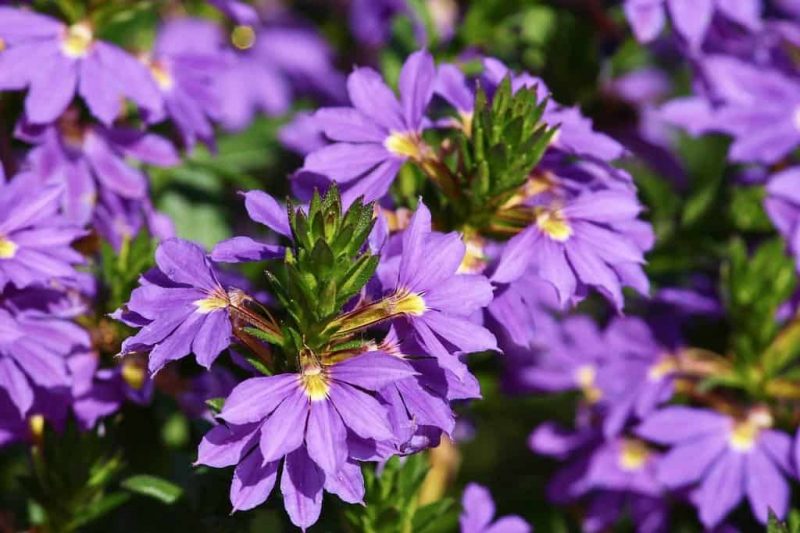Have you ever wondered how to care for scaevola? These pretty little flowers grow well in hot climates – no blossom drops even in the hot summer days. These plants are relatively easy to grow because you don’t need to pinch them or fertilize them regularly. Your plants will survive as long as you give them warmth, sunlight, and water. If your scaevola plants die, it’s because of poor soil drainage and overwatering.
Here’s what you need to know about caring for scaevola plants:

Temperature and Humidity
These plants thrive best in hot weather – around 70 to 85 degrees F work best. If the temperatures are below 60 degrees F, this will stunt the growth of your scaevola. They also thrive in high humidity.
Light
Place your scaevola plants where they can get partial sunlight. Warm-weather plants like scaevola are happier when they’re placed in a shaded location.
Water
Scaevola plants prefer to be dry rather than wet. However, they’re not really xeriscape plants, so you’ll need to water them occasionally. If your plants sit in wet soil, they’re more prone to attracting fungus gnat or develop root rot. For scaevola, it’s important to wait until the soil is dry before you water them again. Your drooping plants will quickly become lively after proper watering.
Fertilizer
Scaevolas are native to Australia and they’re used to challenging growing conditions, so they don’t need much fertilizing. If you do choose to fertilize once in a while, choose a balanced fertilizer for flowers that don’t contain a lot of phosphorous. Too much of it can discolor your flowers and leaves. Only apply fertilizer once a month throughout the growing season.
Soil
You don’t need rich soil for your scaevola plants to grow. However, it’s essential to plant them in well-draining soil. If you plan on growing them in the ground, use raised plant beds, or amended heavy soil.
Potting and Transplanting
Container-grown scaevola plants need a lightweight potting mix to grow. If you live in areas with sandy soil, you can mix it with regular potting soil. Scaevola plants can complete their life cycle without having to repot the plants.
Propagating Scaevola Plants
You can propagate scaevola by using the leaf-cutting method. You can take scaevola cuttings from a non-blooming stem during the end of the summer season so you can overwinter the plants. Dip your scaevola cutting in rooting compound and carefully plant it into the soil. However, make sure not to push it but rather dig a hole and stick the cutting in it. Keep the soil slightly moist but don’t overwater; it’ll damage the roots and stunt plant growth. You should be able to see the roots form after a month.
Growing Scaevola in Containers
Scaevola plants look beautiful when planted in containers. You can place them at the rim of the pots so when they grow, they’ll hang over the sides. Scaevola make great companion plants for other hot-weather flowers like ageratum, begonia, stonecrop, and blanket flower. Similar to scaevola, these types of flowers thrive best in well-draining soil, and make sure not to overwater them.
Reasons Why Investing in a Mini Greenhouse Is The Best
There are several reasons why it’s great to plant scaevola in mini greenhouses. Here are some of them:
Protection from pests and diseases
Scaevola is a hardy plant and they don’t attract pests or diseases. However, they may attract thrips after a long season of drought. Don’t spray insecticides on scaevolas because butterflies are attracted to them for their nectar. Placing them inside a greenhouse keeps them safe from pests and diseases that prey on your plants.
Great for gardeners with limited space
If you want to plant flowers and crops but you don’t have a lot of space, you can use a mini greenhouse. The standard size of a small greenhouse is around six feet, so you can place them on your balcony, patio, or deck. Even though they’re small, mini-greenhouses provide the same benefits as larger greenhouses.
Create a microclimate inside the greenhouse
If you live in cold areas, you can still plant scaevola using a greenhouse. A mini greenhouse lets you create the ideal growing environment for your plants. So, regardless of the weather, you’ll be able to plant any type of plant at any time. You can start growing your scaevolas before the cold season starts in your area. Once the weather warms and the summer season kicks in, you can transfer them into your garden.
Protection from bad weather
Plants won’t do so well if they’re exposed to unpredictable weather conditions. Greenhouses can protect your scaevola plants from ice, snow, heavy rains, and high winds. You can place your plants inside the containers, especially when they’re still vulnerable and growing. You’ll be able to transplant them outside once the weather becomes suitable scaevolas.
Final Thoughts on How to Care for Scaevola
Scaevola plants are a great addition to any space – gardens, living rooms, and more. By knowing how to care for scaevola plants, you’ll be able to enjoy beautiful blooms while attracting butterflies and hummingbirds to your garden. Plant your scaevolas in greenhouses, containers, hanging baskets, or window boxes for added appeal.
